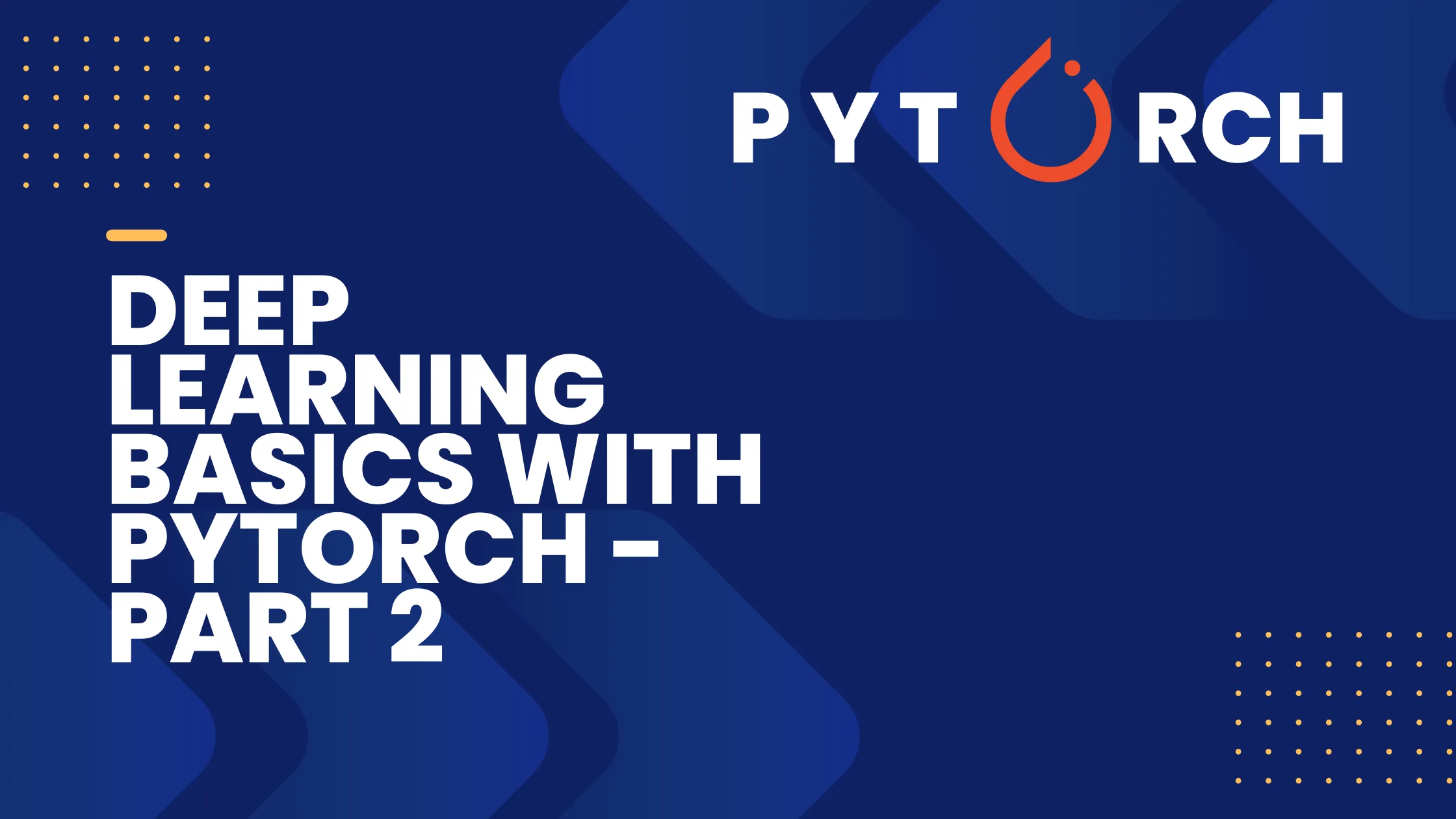Deep Learning Basics with Pytorch - Part 2
Part 2 of Deep Learning Basics with Pytorch using JupyterLab
Now that we have made our hand dirty. We are going to learn some basics.
Linear Regression
Linear Regression is one of the most fundamental algorithm in Machine Learning.
Here’s a simple dataset.
| Study Hours (X) | Exam Score (Y) |
|---|---|
| 1 | 48 |
| 2 | 52 |
| 3 | 71 |
| 4 | 68 |
| 5 | 83 |
| 6 | 89 |
| 7 | 92 |
| 8 | 98 |
We can visualize this on our Jupyter Notebook. Install dependencies:
1
conda install matplotlib seaborn
Run
1
2
3
4
5
6
7
8
9
10
11
12
13
14
15
16
17
18
19
20
21
import matplotlib.pyplot as plt
import seaborn as sns
# Data
study_hours = [10, 20, 30, 40, 50, 60, 70, 80]
exam_scores = [480, 520, 710, 680, 830, 890, 920, 980]
# Create scatter plot
plt.figure(figsize=(8, 5))
sns.scatterplot(x=study_hours, y=exam_scores, s=100, color='blue')
# Add regression line
sns.regplot(x=study_hours, y=exam_scores, scatter=False, color='red')
# Customize plot
plt.title('Study Hours vs Exam Score', fontsize=14)
plt.xlabel('Study Hours', fontsize=12)
plt.ylabel('Exam Score', fontsize=12)
plt.grid(True, alpha=0.3)
plt.show()
As you can see, Sudy Hours vs Exam Score gives a straight line. With this line and data we can actually predict a score. We can only guess, a close guess. The more the hours the more the score. How can we predict?
1
Exam Score = (Slope × Study Hours) + Starting Score
How did we get this? Remember in high school we had an equatiopn for this.
\[Y = mX + b\]Where
- X (Independent Variable): Study Hours
- Y (Dependent Variable): Exam Score
- m = slope → How much Y increases per unit increase in X
- b = intercept → Expected Y value when X = 0
Making any prediction
If X = 45 hours: \(Y=m×45+b≈751\) (close to the actual score)
We can visualize the predicted line.
1
2
3
4
5
6
7
8
9
10
import matplotlib.pyplot as plt
X = [10, 20, 30, 40, 50, 60, 70, 80]
Y = [480, 520, 710, 680, 830, 890, 920, 980]
plt.scatter(X, Y, color='blue', label='Actual Scores')
plt.plot(X, [9.18*x + 338.15 for x in X], 'r-', label='Predicted Line')
plt.xlabel('Study Hours'), plt.ylabel('Exam Score')
plt.legend(), plt.grid(True)
plt.show()
Now we can use PyTorch to implement linear regression.
1
2
3
4
5
6
7
8
9
10
11
12
13
14
15
16
17
18
19
20
21
22
23
24
25
26
27
28
29
30
31
32
33
34
35
36
37
38
39
40
41
42
43
44
45
46
47
48
49
50
51
52
53
54
55
56
57
58
59
60
61
62
63
64
65
66
import torch
import matplotlib.pyplot as plt
# 1. Prepare the data (convert to tensors)
study_hours = torch.tensor([10, 20, 30, 40, 50, 60, 70, 80], dtype=torch.float32)
exam_scores = torch.tensor([480, 520, 710, 680, 830, 890, 920, 980], dtype=torch.float32)
# 2. Create a simple linear model
model = torch.nn.Linear(1, 1) # 1 input, 1 output
# 3. Choose loss function and optimizer
loss_fn = torch.nn.MSELoss() # Mean Squared Error
optimizer = torch.optim.SGD(model.parameters(), lr=0.0001) # Learning rate
# 4. Train the model
losses = []
for epoch in range(1000):
# Reshape input to match model expectations
inputs = study_hours.view(-1, 1)
targets = exam_scores.view(-1, 1)
# Forward pass
predictions = model(inputs)
loss = loss_fn(predictions, targets)
# Backward pass
optimizer.zero_grad()
loss.backward()
optimizer.step()
# Store loss for plotting
losses.append(loss.item())
# 5. Make predictions
with torch.no_grad():
predicted_scores = model(study_hours.view(-1, 1))
# 6. Visualize the results
plt.figure(figsize=(10, 4))
# Plot the data and predictions
plt.subplot(1, 2, 1)
plt.scatter(study_hours, exam_scores, label='Real Data')
plt.plot(study_hours, predicted_scores, 'r-', label='Predictions')
plt.xlabel('Study Hours')
plt.ylabel('Exam Score')
plt.legend()
# Plot the training loss
plt.subplot(1, 2, 2)
plt.plot(losses)
plt.xlabel('Training Epoch')
plt.ylabel('Loss')
plt.tight_layout()
plt.show()
# 7. Print the learned relationship
weight = model.weight.item()
bias = model.bias.item()
print(f"\nLearned formula: Exam Score = {weight:.2f} × Study Hours + {bias:.2f}")
print(f"Meaning: For each additional hour, score increases by ~{weight:.2f} points")
new_hours = torch.tensor([35.0])
predicted = model(new_hours.view(-1, 1))
print(f"35 hours prediction: {predicted.item():.1f} points")
We have converted Python lists to PyTorch tensors. torch.nn.Linear(1, 1) creates a simple y = wx + b model.
- Left plot: Points (real data) with red line (predictions).
- Right plot: Loss decreasing as the model learns.
The output should be: Learned formula: Exam Score = 14.47 × Study Hours + 17.41 Meaning: For each additional hour, score increases by ~14.47 points 35 hours prediction: 523.8 points
For now we have just covered the basic Linear regression. We will continue with PyTorch in next tutorial.



